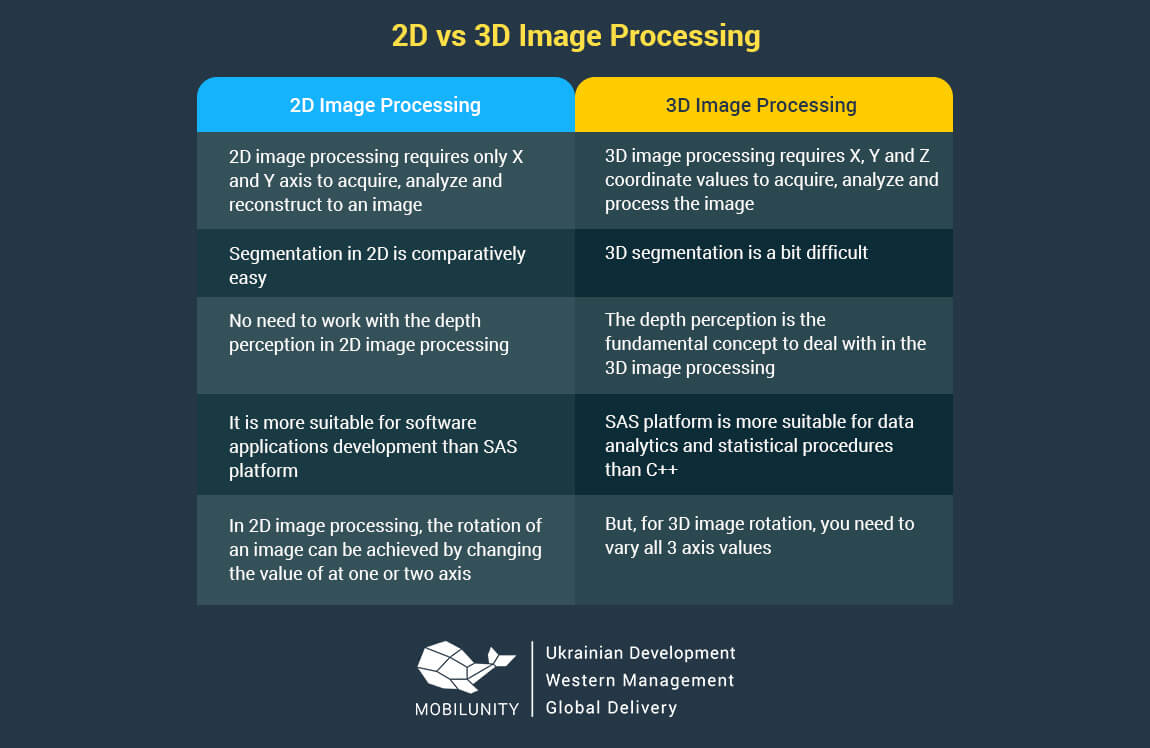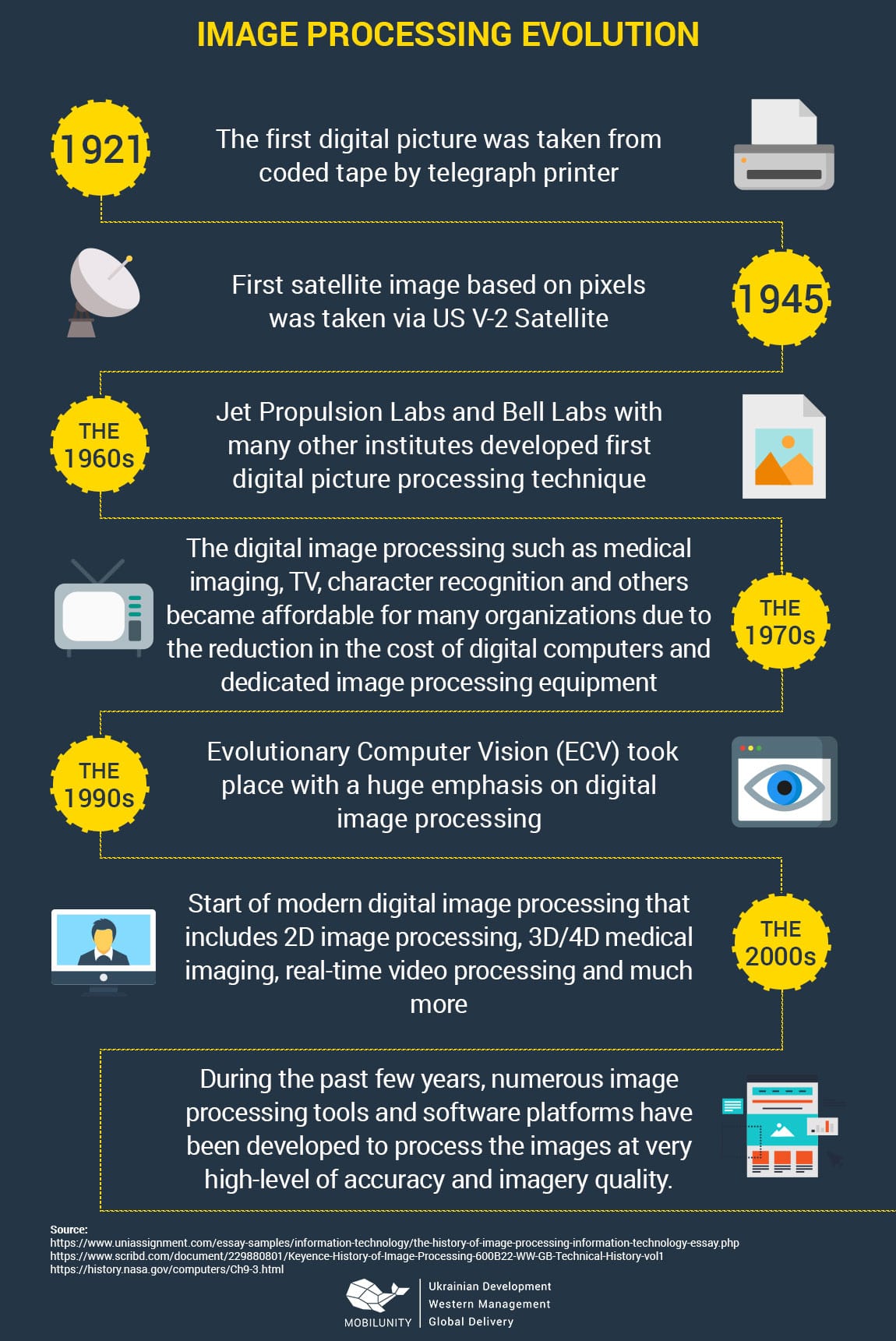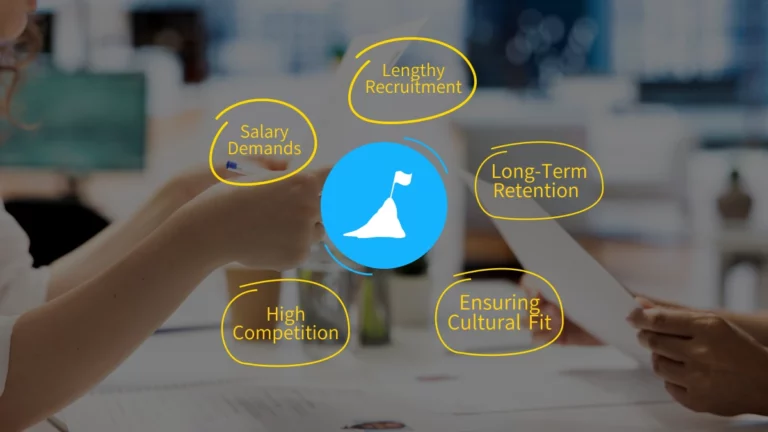Top Reasons to Hire a Digital Image Processing Developer
- Image Processing Developer Role in Image Processing
- Top 5 Image Processing Applications
- What Is Image Processing Algorithm?
- Comparison of 2D and 3D Image Processing
- What Are the Responsibilities of Image Processing Developers?
- Top 5 Technologies or Programming Languages Used in Image Processing
- Top 10 Industries Where Image Processing Is Highly Demanded
- Image Processing Developers Rates in Major Countries
- Final Takeaway
The demand for the image processing developers can be compared to the demand of Java developers for hire, meaning it is pretty high. Right at the time of writing this article, there more than 1,351 image processing SW developer jobs available on Indeed.com web portal. Healthcare, security, surveillance, mobile and machine vision are a few major sectors that are in high need of image processing professionals.
Image recognition market has expanded very fast during the past few years. According to the Grand View Research predictions, the total market size of image processing is expected to reach $77.69 billion by 2025. The growth during the period 2017 to 2025 is expected to remain about 19.2% CAGR. Owing to this huge growth, the demand for the image processing software development is increasing consistently in the marketplace.
Image Processing Developer Role in Image Processing
Image processing is a kind of signal processing through image processing applications. In image processing, certain operations are performed on an image to generate characteristics or features of that particular image. Those characteristics can be used for different purposes like digital access, authorization, or even for image enhancement. The major areas of image processing include pattern recognition, object recognition, QR recognition, and facial recognition.
The image processing algorithms are the major software functions, which are used for the image acquisition, refinement, and synthesis during the entire procedure of image processing. Those algorithms are basically the signal processing functions based on certain mathematical formulas, which are programmed in the software.
Image Processing Evolution
The history of manual image processing starts with the human being started visualizing the images and carving them on stones or other material. Since then, image processing is continuously evolving through different eras. Let’s have a look at different events in chronicle order to understand the evolution of digital image processing.
During the past few years, numerous image processing tools and software platforms have been developed to process the images at very high-level of accuracy and imagery quality.
Top 5 Image Processing Applications
According to the Orbis Research market forecast, the total market size of image processing software is expected to reach $1.03 billion by 2023 with an estimated growth of 6.8% CAGR during the period of 2017 to 2023. The global market size of medical image processing is expected to cross the $4.51 billion by 2024, according to the Grand View Research report.
The major image processing software applications are mentioned below.
#1 Adobe Photoshop

Adobe Photoshop is one of the top image editing applications extensively used in many industries. It has numerous features and capabilities like a large number of design tools, compatibility with both the web and mobile, plenty of libraries, and much more.
#2 Serif Affinity

Affinity Serif is another popular image editing software in the marketplace. It was created in 2015, but within a short span of time, it has become very popular in many industries due to its wide range of features and capabilities. The main features include the advanced user interface, support for over 15 file types, easy to work, and many others.
#3 Corel Paintshop Pro

Corel Paintshop Pro is a powerful image editing software with the capabilities of artistic flair editing. The main features of Corel Paintshop Pro include raw image processing, highly featured art media brushes, support for automatic and manual editing, and many other functions.
#4 CyberLink PhotoDirector

The CyberLink PhotDirector is a comprehensive photo and video editing solution. It offers numerous features, such as artistic editing, streamlines editing workflow, numerous creative functions, and much more. It is suitable for travel, landscape, family, and portrait photography. It possesses many easy to use functions and features.
#5 CaptureOne

The CaptureOne is a powerful digital image processing and analysis software tool, which can process the raw images taken from numerous digital cameras in multiple formats. The main features & capabilities of this software application include image cataloging, tethered photography, image editing, and raw image processing. It is very easy to work with this software.
What Is Image Processing Algorithm?
The image processing algorithms are mathematical functions that are used to generate, process, and show a digital image from the data from the digital sensors. The image processing algorithms are also used to transmit the images over the communication links from one place to another one. The mathematical functions are coded into the computer languages to create certain functions for image processing in computer graphics. A few examples of the algorithmic functions include:
- Translating sensor signals into digital images
- Segmentation of objects in an image
- Removal of noises from the digital images
- Carving out sizes and shapes of the images
- Compressing the image data
- Coding image data for transportation
- Enhancing the image quality
- Moving the image and its directions
- Motion detection of a moving body
List of Steps for Image Processing
Let’s have a look at the steps for image processing, commonly referred to as digital image processing (DIP) in a sequential order, as mentioned below:
- Image acquisition
- Enhancement of image
- Image restoration
- Processing of image color
- Multi-resolution & Wavelet processing
- Compression of image
A few more steps related to image presentation and attributes, which are also the part of image processing, are listed below:
- Image morphology processing
- Image segmentation
- Representing an image
- Object recognition of image
- Image transmission over the communication link
Comparison of 2D and 3D Image Processing
The fundamental concepts of both 2D and 3D image processing are same, but 3D processing requires additional processing as compared to 2D image processing. Many algorithms for 3D processing vary from the 2D image processing. The best image processing software tools in the market normally have the capabilities to process both 2D and 3D images.

What Are the Responsibilities of Image Processing Developers?
The responsibilities of such SW developer for image processing applications vary with respect to the industry and job category. For instance, the responsibilities of a biomedical image processing developer would be a little bit different from the security surveillance engineer.
Let’s generalize the major responsibilities of an image processing developer:
- Understanding and developing image processing workflow
- Working with all image processing steps from image acquisition to image morphology
- Working knowledge the latest image processing tools
- Developing image processing algorithms
- Testing of digital image processing (DIP) algorithms
- Analysis of sensor data and development of software tools
- Collaborating with the field teams and electronic engineers
- Extraction of image features through machine learning tools
- Interpreting the visual data and creating reports and presentations
- Designing and developing image processing software components
- Writing, testing and debugging of the codes
Top 5 Technologies or Programming Languages Used in Image Processing
The digital image processing (DIP) has become so sophisticated and complex that we cannot have a full command by learning one particular technology, language or a platform. You need to have knowledge of mathematics, computer science, computer programming and much more. You need to have command over these technologies to qualify for the basic-level developer with 2D image processing skills. You need extra expertise for 3D image processing.
A large range of computer vision and image processing (CVIP) technologies are emerging in the marketplace. Five most demanding technologies and programming languages are mentioned below:
OpenCV Library
OpenCV is an open source platform, which consists of a large number of computer vision and image processing library functions. This platform is free for both commercial and academic use. The OpenCV library offers an interface for Java, C++, and Python. It is compatible with numerous OS systems like Windows, Linux, Android, iOS, and others. It is powered by a large community of over 47 thousand people.
C++ Language
C++ is a general purpose and a powerful computer programming language. It supports object-oriented programming. It is extensively used for development of image processing software, tools, and platforms. Owing to its powerful functions and arrays, C++ is very popular in digital image processing field. The combination of OpenCV and C++ is one of the best solutions for image processing programming.
MATLAB Language
MATLAB is a powerful and easy to learn computer programming language, which is specially designed for the scientific and engineering programming. It has powerful capabilities to program different kinds of scientific algorithms and mathematical formulas for image processing. With a shortcode in MATLAB, you can program great scientific functions. Image processing uses numerous mathematical algorithms; so it is one of the popular languages in image processing field.
Python Language
Python is a powerful scripting language that works well with the OpenCV open source library for image processing. It is a high-level and general purpose language extensively used for machine learning, computer vision, image processing, and many other software programs. A large and robust standard library is one of the major capabilities of this language. Python language is comparatively easy to learn and work with.
Java Language
Java programming language is one of the most popular software programming languages in the marketplace. Java is an object-oriented multipurpose language. Java offers powerful classes for image processing. It is widely used in digital image processing nowadays. The combination of Java and OpenCV offers huge flexibility to develop image processing algorithms and software programs.
Top 10 Industries Where Image Processing Is Highly Demanded
Digital image processing is used in numerous industries. A few of them are mentioned below:
#1 Healthcare
The healthcare benefits the most from the digital image processing. The role of image processing in different digital reports like MRI, microscopic images, and CT scan is huge. Many medical procedures are also benefiting from the power of digital image processing.
#2 Access Control
The digital image processing is extensively being processed in the physical access control for buildings, offices and other places. In collaboration with numerous communication technologies, the physical access control is being centralized for an effective use of it.
#3 Surveillance & Security
Physical border surveillance and security is another important field in which digital image processing is extensively used to safeguard the physical boundaries. Numerous security systems are being deployed not only on the country borders but also on the boundaries of important security installations and other places of critical importance.
#4 Gaming
Gaming is a cruising field in which the modern technologies are used extensively. The image processing is also one of those technologies. Different game engines use the power of image processing to create a great user experience. The real-time texture manipulation in 3D games is one of the examples of image processing in the gaming industry.
#5 Digital Cinema
The modern cinema and film industry are using digital image processing extensively to create the great user experience in the entertainment industry. The 3D theaters are showing the films, which use digital processing extensively in the productions. The animated films are other examples of image processing technology.
#6 Industrial Automation
Industrial automation is one of the most important fields in which DIP is extensively used to carry-out numerous automated functions. The robotics in industrial automation is one of the examples that use the power of DIP and computer vision technologies.
#7 Home Automation
Nowadays, the power of image processing is extensively used in home automation. The efficient use of lights, air conditioners, heating systems and security access are a few examples that use the power of digital image processing. The use of digital image processing in other home automation processes is also being studied.
#8 Mobile
A smartphone is a very basic need for everybody nowadays. The security of mobile devices, code scanning, eCommerce activities, online payments and many other similar types of activities use digital image processing capabilities. A mobile is not limited to just a communication device now. It has become an entertainment tool as well; so numerous video and gaming apps are installed on those devices, which use the digital image processing in their functionalities.
#9 Digital Camera
Different functions in a camera such as zooming, skin toning, image scaling, image effects are the examples of digital image processing. The modern digital cameras have a wide range of capabilities and features powered by the digital image processing.
#10 Robotics
The robots that follow a line for the linear movement use the image processing technology. Certain lines are drawn as the path of robots to move and carry out certain tasks. The image processing helps them determine the right path for them to follow. Object recognition in robots is also done by applying the power of image processing technology.
Image Processing Developers Rates in Major Countries
Find out more about:
- What are the best software companies in Italy?
Final Takeaway
Digital image processing is in high demand all around the world. The salaries of DIP developers are very high in many European, North American and other developed countries. Mobilunity offers the professional-level digital image processing services remotely to the customers across the globe. If you are looking to hire Yii developer, Java consultants or website development consultant for hire to build a fast, functional, and conversion-driving project, contact Mobilunity for professional assistance.
The company offers highly skilled and experienced image processing developers at very competitive and fixed prices without any hidden charges at all. Take advantage of IT projects outsourcing and build apps and websites for your business with Mobilunity! Mobilunity is a Ukraine based company, which specializes in the dedicated software development services to create great value for the customers.
If you are looking for the dedicated digital image processing developers, we can help you!
Disclaimer: All salaries and prices mentioned within the article are approximate numbers based on the research done by our in-house Marketing Research Team. Please use these numbers as a reference for comparison only. Feel free to use the contact form to inquire on the specific cost of the talent according to your vacancy requirements and chosen model of engagement.
















